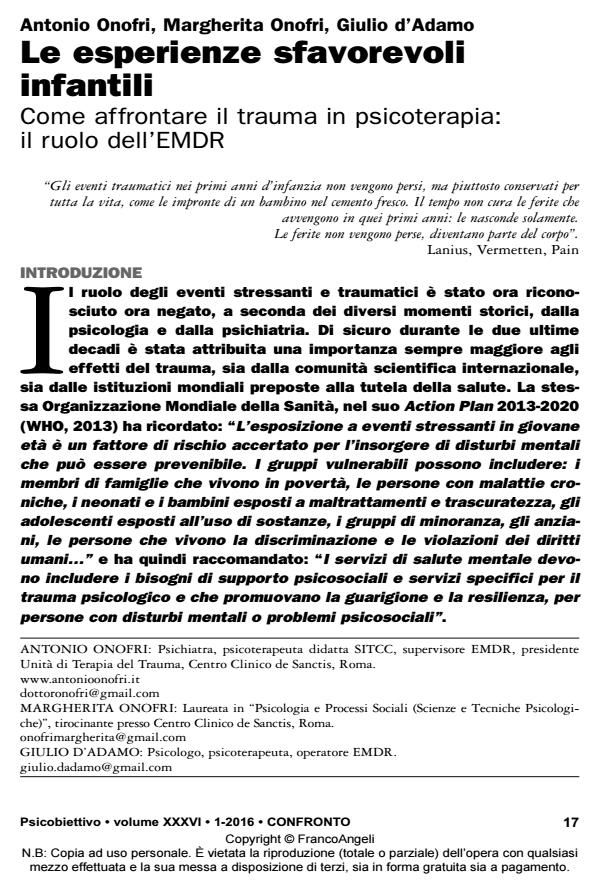Le esperienze sfavorevoli infantili Come affrontare il trauma in psicoterapia: il ruolo dell’EMDR
Titolo Rivista PSICOBIETTIVO
Autori/Curatori Antonio Onofri, Margherita Onofri, Giulio D'Adamo
Anno di pubblicazione 2016 Fascicolo 2016/1
Lingua Italiano Numero pagine 21 P. 17-37 Dimensione file 138 KB
DOI 10.3280/PSOB2016-001002
Il DOI è il codice a barre della proprietà intellettuale: per saperne di più
clicca qui
Qui sotto puoi vedere in anteprima la prima pagina di questo articolo.
Se questo articolo ti interessa, lo puoi acquistare (e scaricare in formato pdf) seguendo le facili indicazioni per acquistare il download credit. Acquista Download Credits per scaricare questo Articolo in formato PDF

FrancoAngeli è membro della Publishers International Linking Association, Inc (PILA)associazione indipendente e non profit per facilitare (attraverso i servizi tecnologici implementati da CrossRef.org) l’accesso degli studiosi ai contenuti digitali nelle pubblicazioni professionali e scientifiche
Gli Autori riassumono innanzitutto i risultati del grande studio epidemiologico riguardante le Adverse Childhood Experiences (Esperienze Infantili Avverse) denominato Studio ACE, che mostra una correlazione diretta tra queste esperienze, i comportamenti a rischio per la salute, le malattie fisiche e psichiatriche. Discutono quindi le ipotesi riguardanti gli effetti delle ACEs sullo sviluppo neurobiologico e psicosociale. Illustrano infine il modello di terapia per fasi per gli stati post-traumatici e come l’approccio EMDR possa essere utilizzato per tutte e tre le fasi del processo terapeutico per questo tipo di condizioni psicopatologiche.
Parole chiave:Esperienze sfavorevoli infantili; trauma; psicoterapia cognitivo-comportamentale; sviluppo infantile; EMDR.
- La formazione specialistica degli psicologi nel progetto "Non Vedo, Non Sento, Non Parlo" a favore dei minori vittime di Esperienze Sfavorevoli Infantili - ESI Daniela D’Elia, Luna Carpinelli, Annamaria Scapicchio, Antonella Tomasetti,, Giulia Savarese, in MALTRATTAMENTO E ABUSO ALL'INFANZIA 1/2024 pp.87
DOI: 10.3280/MAL2024-001005
Antonio Onofri, Margherita Onofri, Giulio D'Adamo, Le esperienze sfavorevoli infantili Come affrontare il trauma in psicoterapia: il ruolo dell’EMDR in "PSICOBIETTIVO" 1/2016, pp 17-37, DOI: 10.3280/PSOB2016-001002